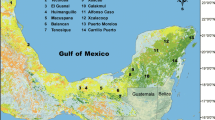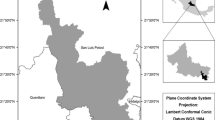Abstract
Apomictic microspecies, for example those of the genus Alchemilla, are often difficult to distinguish. Still, their differences are thought to be persistent due to apomixis. Apomicts are argued to have general-purpose genotypes. The present study aims to assess the variation of morphological characters of Alchemilla depending on environmental conditions both in nature and experimentally; to evaluate the efficacy of characters for identifying the different microspecies; to assess the similarity of different microspecies; and to determine if Alchemilla microspecies have general-purpose genotypes that are not dependent on environmental conditions. The variability of selected characters in seven microspecies of Alchemilla was studied in nature and five microspecies were grown in a common garden experiment. The growing conditions of the latter were subjected to various manipulations (fertilization, shading and irrigation). Typical natural habitats of Alchemilla exhibited only small differences. Environmental conditions therefore had little effect on morphological characters. Neither cultivation in the common garden nor manipulation of conditions therein had a significant impact on the discrimination of microspecies. However, the metric characters were larger in the garden relative to those observed in nature, particularly under fertilization. Fertilization affected most characters, whereas shading and irrigation did not. The most effective characters for discriminating between microspecies were the ratios of the metric characters. Two species pairs: A. vulgaris and A. micans, as well as A. glaucescens and A. hirsuticaulis were morphologically close; however, the species within these pairs could still be distinguished. The morphological characters of Alchemilla microspecies were only slightly dependent on the environmental conditions.




Similar content being viewed by others
References
Baeva VM, Bobrova, VK, Troitsky AV, Antonov AS (1998) RAPD analiz roda manzhetka (RAPD analysis of the genus Alchemilla). Farmatsiya 2:38–41
Bayer RJ (1997) Antennaria rosea (Asteraceae) – A model group for the study of the evolution of polyploid agamic complexes. Opera Bot 132:53–65
Benjamini Y, Hochberg Y (1995) Controlling the false discovery rate – a practical and powerful approach to multiple testing. J Roy Stat Soc B 57:289–300
Bierzychudek P (1989) Environmental sensitivity of sexual and apomictic Antennaria: do apomicts have general-purpose genotypes? Evolution 43:1456–1466
Bradshaw ME (1963) Studies on Alchemilla filicaulis Buser sensu lato and A. minima Walters. Introduction, I. Morphological variation in A. filicaulis sensu lato, and II. Cytology of Alchemilla filicaulis sensu lato. Watsonia 5:304–326
Dickinson TA (1998) Taxonomy of agamix complexes in plants: a role for metapopulation thinking. Folia Geobot 33:327–332
Eichwald K (1956) Perekond kortsleht – Alchemilla L. (Genus lady’s mantle-Alchemilla L.). In Eichwald K, Talts S, Vaga A, Varep E (eds) Eesti NSV floora (Flora of the Estonian SSR), 2. Eesti Riiklik Kirjastus, Tallinn, pp 358–408
Ellenberg H, Weber HE, Düll R, Wirth V, Werner W, Paulißen D (1991) Zeigerwerte von Pflanzen in Mitteleuropa. Scripta Geobot 18:1–248
Eriksson T, Hibbs MS, Yoder AD, Delwiche CF, Donoghue MJ (2003) The phylogeny of Rosoideae (Rosaceae) based on sequences of the internal transcribed spacers (ITS) of nuclear ribosomal DNA and the TRNL/F region of chloroplast DNA. Int J Pl Sci 164:197–211
Ertsen ACD, Alkemade JRM, Wassen MJ (1998) Calibrating Ellenberg indicator values for moisture, acidity, nutrient availability and salinity in the Netherlands. Vegetatio 135:113–124
Fröhner S (1975) Kritik an der europäischen Alchemilla -Taxonomie. Feddes Repert 86:119–169
Fröhner S (1995) Alchemilla. In Scholz H (ed) Illustrierte Flora von Mitteleuropa 4(2B), ed. 2. Blackwell Wissenschafts-Verlag, Berlin-Wien, pp 13–242
Fröhner S (1999) Zum Stand der Alchemilla-Forschung in Europa. Acta Bot Fenn 162:175–178
Glazunova KP (1983) Mikrosprorogenez i mikrogametofitogenez u Alchemilla filicaulis Buser (Microsporogenesis and microphytogenesis in Alchemilla filicaulis Buser). Naucn Dokl Vysshei Shkoly Biol Nauki 7:79–83
Glazunova KP, Myatlev VD (1990) Korrelyatsionnaya struktura i izmenchivost priznakov pri regulyarnom apomiksise (na primere agamnogo vida Alchemilla monticola Opiz) (Correlation structure and variability of characters in the case of regular apomixis (Alchemilla monticola Opiz as an example of agamic species)). Byull Moskovsk Obshch Isp Prir, Otd Biol 95:96–109
Gonzalez AV, Gianoli E (2004) Morphological plasticity in response to shading in three Convolvulus species of different ecological breadth. Acta Oecol 26:185–190
Grimshaw HJ, Havens K, Sharfstein B, Steinman A, Anson D, East T, Maki RP, Rodusky A, Jin K-R (2002) The effects of shading on morphometric and meristic characteristics of Wild Celery, Vallisneria americana Michx., transplants from Lake Okeechobee, Florida. Arch Hydrobiol 155:65–81
Hayirlioğlu-Ayaz S, İnceer H, Frost-Olsen P (2006) Chromosome counts in the genus Alchemilla (Rosaceae) from SW Europe. Folia Geobot 41:335–344
Izmailow R (1994a) Embryo and endosperm relations at early stages of their development in Alchemilla (subsect. Heliodrosium (Rosaceae)). Polish Bot Stud 8:61–67
Izmailow R (1994b) Further observations in embryo sac development in Alchemilla L. (subsection Heliodrosium Rothm.). Acta Biol Cracov, Ser Bot 36:37–41
Jongman RHG, Ter Braak CJF, van Tongeren OFR (1995) Data analysis in community and landscape ecology. Cambridge University Press, Cambridge
Juzepchuk SV (1941) Manzhetka – Alchemilla L. (Lady’s mantle – Alchemilla L.). In Flora SSSR (Flora URSS), 10. Izd. Akad. Nauk SSSR, Moskva-Leningrad, pp 289–410
Koltunow AM (1993) Apomixis: Embryo sacs and embryos formed without meiosis or fertilization in ovules. Pl Cell 5:1425–1437
Lundh-Almestrand A (1958) Studies on some microspecies of Alchemilla vulgaris L. Bot Not 111:587–607
Menemen Y, Hamzaoglu E (2002a) Alchemilla boluensis (Rosaceae), a new species from the west Black Sea region (Bolu, Turkey). Nordic J Bot 22:325–328
Menemen Y, Hamzaoglu E (2002b) Alchemilla ovitensis (Rosaceae), a new species from the west Black Sea region, Turkey. Annales Bot Fenn 39:231–234
Murbeck S (1901) Parthenogenetische Embryobildung in der Gattung Alchemilla. Lunds Univ Ǻrsskr 36:1–41
Plocek A (1976) New varieties of Alchemilla monticola (Rosaceae), and the taxonomic issue involved. Candollea 31:95–105
Rothmaler W (1937) Systematische Vorarbeiten zu einer Monographie der Gattung Alchemilla (L.) Scop. VII. Aufteilung der Gattung und Nomenklatur. Feddes Repert 42:146–173
Rothmaler W (1941) Systematische Vorarbeiten zu einer Monographie der Gattung Alchemilla (L.) Scop. IX. Über Alchemilla – Arten aus Osteuropa und Asien. Feddes Repert 50:78–80, 245–255
Sepp S (1999) Perekond kortsleht – Alchemilla L. (Genus lady’s mantle – Alchemilla L.). In Leht M (ed) Eesti taimede määraja (Identification keys of the Estonian vascular plants). EPMÜ ZBI & Eesti Loodusfoto, Tartu, pp 156–163
Sepp S, Paal J (1998) Taxonomix continuum of Alchemilla (Rosaceae) in Estonia. Nord J Bot 18:519–535
Sepp S, Paal J (2001) Patterns and relationships between and within the sections Alchemilla and Ultravulgares of the genus Alchemilla (Rosaceae) in Estonia. Nord J Bot 20:561–571
Sepp S, Bobrova VK, Troitsky AK, Glazunova KP (2000a) Genetic polymorphism detected with RAPD-analysis and morphological variability in some microspecies of apomictic Alchemilla L. Annales Bot Fenn 37:105–123
Sepp S, Nahtman T, Möls T, Paal J (2000b) Study of the multivariate structure of the Estonian Alchemilla L. (Rosaceae) microspecies: an example of the structural indices approach. Proc Estonian Acad Sci Biol Ecol 49:289–301
Shivastava R, Cucuat N, John GW (2007) Effects of Alchemilla vulgaris and glycerine on epithelial and myofibroblast cell growth and cutaneous lesion healing in rats. Phytotherapy Res 21:369–373
Stace CA (1998) Species recognition in agamosperms – the need for a pragmatic approach. Folia Geobot 33:319–326
StatSoft Inc. (2001) Statistica, data analysis software system, version 6. Statsoft Inc, Tulsa, available at: www.statsoft.com
Strasburger E (1905) Die Apogamie der Eualchimillen und allgemeine Gesichtspunkte, die sich aus ihr ergeben. Jahrb Wiss Bot 41:88–164
Thiel H (2004) Die Arten der Gattung Alchemille L. (Rosaceae) in Südniedersachsen – Verbreitung, Lebensräume, Indikatoreigenschaften, Gefährdungen. Braunschweig Naturk Schriften 7:73–107
Tikhomirov VN (1967) Nekotorye osobennosti sistematiki obligatnykh apomiktov na primere roda Alchemilla L. (Special features of systematics of obligatory apomicts on example of Alchemilla L.). In Anonymous (ed) Soveshchanie po obëmu vida i vnutrividovoi sistematike 4–7. Apr. 1967. Tezisy dokladov (Meeting about species scope and infraspecific taxonomy 4–7. Apr. 1967. Theses of presentations). Leningrad, pp 53–55
Tikhomirov VN, Sepp S (1993) Perekond kortsleht Eestis (Genus lady’s mantle in Estonia). Rukkilill 4:15–22
Tikhomirov VN, Notiv AA, Petukhova LV, Glazunova KP (1995) Rod manzhetka (Genus lady’s mantle – Alchemilla L.). In Pavlov VN, Tikhomirov VN (eds) Biologicheskaya flora Moskovskoi oblasti (Biological flora of the Moscow region), 10. Izd. Mosk. Univ., Moskva, pp 83–118
Turesson G (1943) Variation in the apomictic microspecies of Alchemilla vulgaris L. Bot Not 1943:413–427
Turesson G (1956) Variation in the apomictic microspecies of Alchemilla vulgaris L. II. Progeny tests in agamotypes with regard to morphological characters. Bot Not 109:400–404
Turesson G (1957) Variation in the apomictic microspecies of Alchemilla vulgaris L. III. Geographical distribution and chromosome number. Bot Not 110:413–422
Urbas P, Zobel K (2000) Adaptive and inevitable morphological plasticity of three herbaceous species in a multi-species community: Field experiment with manipulated nutrients and light. Acta Oecol 21:139–147
Vanderpoorten A, Jacquemart A-L (2004) Evolutionary mode, tempo, and phylogenetic association of continuous morphological traits in the aquatic moss genus Amblystegium. J Evol Biol 17:279–287
Verhoeven KJF, Simonsen KL, McIntyre LM (2005) Implementing false discovery rate control: increasing your power. Oikos 108:643–647
Walters SM (1972) Endemism in the genus Alchemilla in Europe. In Valentine DH (eds) Taxonomy, phytogeography and evolution. Academic Press, London, pp 301–305
Walters SM (1986) Alchemilla: a challenge to biosystematists. Acta Univ Upsal, Symb Bot Upsal 27:193–198
Acknowledgements
Thanks go to professor J. Paal for help in planning the experiment. We are very grateful to Dr. J. Liira for help with statistics. Our gratitude belongs also to Dr. D. Prati and three anonymous reviewers for useful comments on the first version of the manuscript. We thank the American Journal Experts for revising language. The study was financed by the Estonian Science Foundation, grant nr. 5815 and also supported by the European Union through the European Regional Development Fund (Centre of Excellence FIBIR).
Author information
Authors and Affiliations
Corresponding author
Rights and permissions
About this article
Cite this article
Pihu, S., Hõimra, J., Köster, E. et al. Environmentally Dependent Morphological Variability in Seven Apomictic Microspecies from Alchemilla L. (Rosaceae). Folia Geobot 44, 159–176 (2009). https://doi.org/10.1007/s12224-009-9034-0
Received:
Accepted:
Published:
Issue Date:
DOI: https://doi.org/10.1007/s12224-009-9034-0




